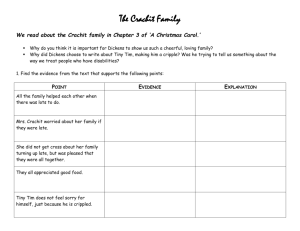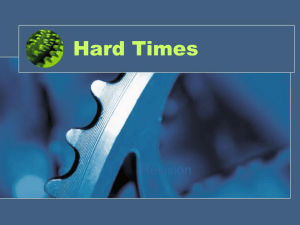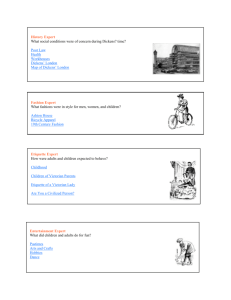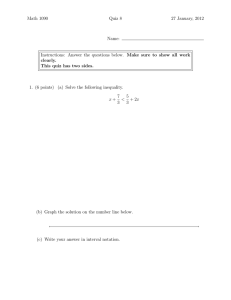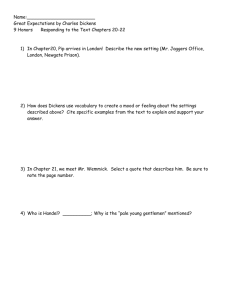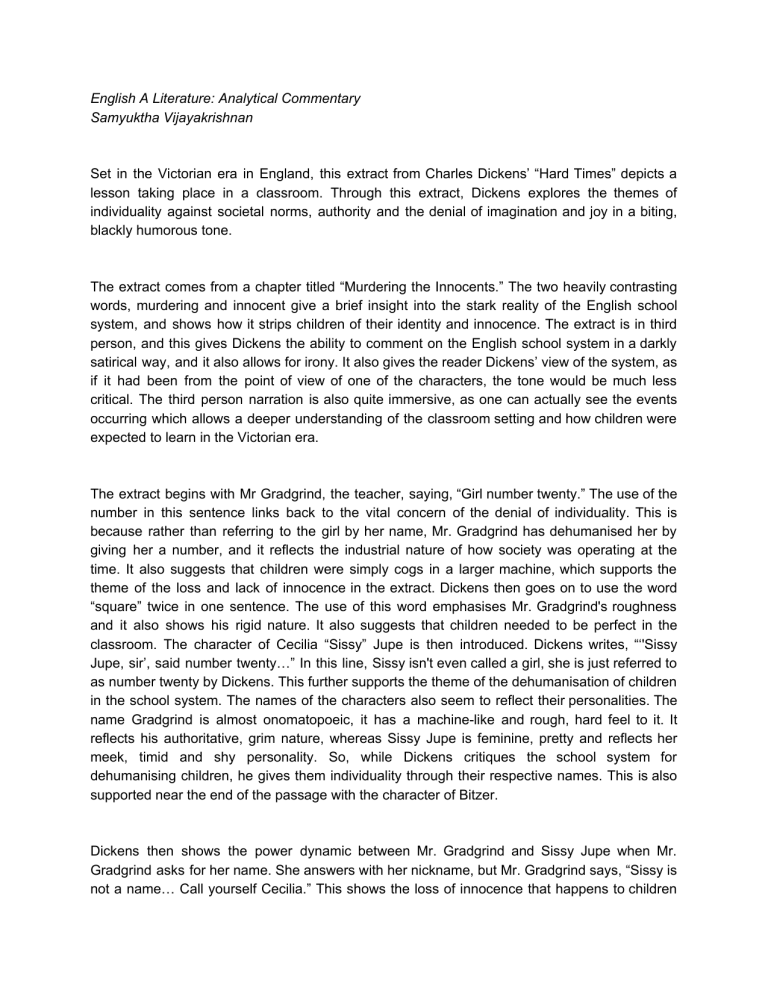
English A Literature: Analytical Commentary Samyuktha Vijayakrishnan Set in the Victorian era in England, this extract from Charles Dickens’ “Hard Times” depicts a lesson taking place in a classroom. Through this extract, Dickens explores the themes of individuality against societal norms, authority and the denial of imagination and joy in a biting, blackly humorous tone. The extract comes from a chapter titled “Murdering the Innocents.” The two heavily contrasting words, murdering and innocent give a brief insight into the stark reality of the English school system, and shows how it strips children of their identity and innocence. The extract is in third person, and this gives Dickens the ability to comment on the English school system in a darkly satirical way, and it also allows for irony. It also gives the reader Dickens’ view of the system, as if it had been from the point of view of one of the characters, the tone would be much less critical. The third person narration is also quite immersive, as one can actually see the events occurring which allows a deeper understanding of the classroom setting and how children were expected to learn in the Victorian era. The extract begins with Mr Gradgrind, the teacher, saying, “Girl number twenty.” The use of the number in this sentence links back to the vital concern of the denial of individuality. This is because rather than referring to the girl by her name, Mr. Gradgrind has dehumanised her by giving her a number, and it reflects the industrial nature of how society was operating at the time. It also suggests that children were simply cogs in a larger machine, which supports the theme of the loss and lack of innocence in the extract. Dickens then goes on to use the word “square” twice in one sentence. The use of this word emphasises Mr. Gradgrind's roughness and it also shows his rigid nature. It also suggests that children needed to be perfect in the classroom. The character of Cecilia “Sissy” Jupe is then introduced. Dickens writes, “‘'Sissy Jupe, sir’, said number twenty…” In this line, Sissy isn't even called a girl, she is just referred to as number twenty by Dickens. This further supports the theme of the dehumanisation of children in the school system. The names of the characters also seem to reflect their personalities. The name Gradgrind is almost onomatopoeic, it has a machine-like and rough, hard feel to it. It reflects his authoritative, grim nature, whereas Sissy Jupe is feminine, pretty and reflects her meek, timid and shy personality. So, while Dickens critiques the school system for dehumanising children, he gives them individuality through their respective names. This is also supported near the end of the passage with the character of Bitzer. Dickens then shows the power dynamic between Mr. Gradgrind and Sissy Jupe when Mr. Gradgrind asks for her name. She answers with her nickname, but Mr. Gradgrind says, “Sissy is not a name… Call yourself Cecilia.” This shows the loss of innocence that happens to children when they start school, and how they cannot enjoy their childhood any longer. Dickens then writes, “... returned the young girl in a trembling voice…” The use of the word trembling emphasises Sissy’s timidness and weakness, and strengthens the binary opposition between Mr. Gradgrind and Sissy, as their characters are exact opposites. By making Sissy fragile and meek, Dickens highlights the opposite qualities in Mr. Gradgrind without explicitly stating them. Dickens also writes that Sissy curtseys to Mr. Gradgrind, which further emphasises the sense of power in the extract, and the powerlessness of Sissy. The physical act of curtseying literally puts Sissy underneath Mr. Gradgrind, and shows that students and teachers are not equal, students will always be inferior to teachers. Dickens communicates this throughout the extract. Mr. Gradgrind then goes on to say, “What is your father?” Instead of using the word how, Dickens uses the word ‘what’ to link back to the theme of dehumanisation. However, this time, this categorisation is not only restricted to the classroom, but has been extended to ordinary people as well. This reflects the attributes of society at that time and its need to fit everyone into a category. Sissy then replies with, “He belongs to the horse-riding, if you please…” The use of the word belong in this sentence suggests that once a profession was chosen, it could never be left. This shows the rigidity of the society they were living in, and how unforgiving it was. Dickens then emphasises the strictness of the classroom and the school system by repeating the word ‘here’. The use of this word and the forcefulness of it reflects Mr. Gradgrind’s authoritativeness and the rigorousness of the classroom. Dickens also highlights society’s need to categorise again when Mr. Gradgrind says, “He is a veterinary surgeon, a farrier and horse-breaker.” This is quite untrue, as Sissy Jupe’s father is actually a horse rider in a circus. This shows how everyone had to fit into a category, and links back to the theme of dehumanisation and the harshness of societal norms. Dickens then uses an aside when he writes, “(Sissy Jupe thrown into the greatest alarm by this demand).” This creates a sense of dark humour, and allows for some comedy and irony, which aids the satirical tone of the extract. Mr. Gradgrind then continues with the dehumanisation of Sissy, referring to her continuously as girl number twenty, and the word square is also repeated. This indicates Gradgrind and the school system’s need for perfection, and the clinical nature of school. Robotic, impersonal language is then used to describe the physical nature of the classroom, but is contrasted by the sunlight that “irradiated Sissy.” This suggests that in a classroom that is dark, machine like and grey, Sissy is the only colour and joy present. The character of Bitzer is then introduced, and Dickens writes, “... if he were cut, he would bleed white.” Dickens uses the ray of sunlight to highlight the true personality of the two characters. For example, it radiates Sissy and somehow makes Bitzer seems even paler. The sunlight can also be said to represent the school system, and Dickens uses it to show the different stages of it. Bitzer has probably been in the system for much longer than Sissy, and is drab and lifeless. However, Sissy being relatively new, is still lively and joyous. This again highlights the critical tone that the extract is written with and indicates Dickens’ personal view of the school system. The classroom is also described in a clinical, mathematical way. Dickens writes, “... sat on the face of the inclined plane in two compact bodies, divided up the center by a narrow interval…” The dispassionate and detached tone with which Dickens describes the classroom echoes the personality of Mr. Gradgrind, and how sterile and impersonal the school system is. Bitzer then takes on the duty of describing a horse, and gives a purely scientific and impersonal description. The language he uses is sterile and clinical, and it shows the indifference of the school system, and allows Dickens to critique its nature, and more broadly, the rigidity of society. The name Bitzer also contradicts Mr. Gradgrind’s opposition to nicknames. This shows that boys were given more freedom in society, and highlights the patriarchal nature of it. Dickens also critiques the rote learning technique that it used through the satirical tone with which he writes, “Thus (and much more) Bitzer.” Once again, Dickens harshly critiques the Victorian school system. The idea that Sissy is the only point of colour in a drab, lifeless environment is strengthened when Dickens repeats the word “blush”. The use of this soft word and the lack of plosive consonants provides a stark contrast to the clinical and sterile language used previously, and reflects how different Sissy is to the other children. Dickens describes Bitzer’s eyelashes to look like, “the antennae of busy insects…” This metaphor of busy bees or insects shows how children were just considered to be workers or labourers in the school system, and not there to actually learn. In a darkly humorous, biting satire, Dickens critiques the English school system by exploring notions of individuality, categorisation and the influence of authority. He uses symbolic devices such as the ray of sunlight, and the individuality that can be achieved through names. He also uses clinical, plain language to describe the nature of the school system, and in a much broader sense, the rigid nature and structure of society.

